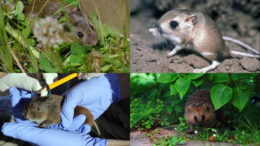Rodents often get a bad rap.
 Sure, some of them carry diseases or have become invasive pests — I’m lookin’ at you, Rattus rattus — but they’re also evolutionary marvels who have adapted to live in almost every region on Earth. They’re found in marshes, deserts, jungles and everything in between.
Sure, some of them carry diseases or have become invasive pests — I’m lookin’ at you, Rattus rattus — but they’re also evolutionary marvels who have adapted to live in almost every region on Earth. They’re found in marshes, deserts, jungles and everything in between.
Along the way, these small-bodied mammals have become essential to their native ecosystems. They serve as prey for larger animals, while their own eating habits help to disperse seeds and spores, pollinate plants, cycle soil nutrients, and shape vegetation patterns.
Despite the ecological benefits they bring, smaller mammals don’t get much attention from the media or scientific journals. They also typically lack the same conservation attention received by more charismatic species such as wolves and tigers, even though they, too, face habitat loss, pesticides, invasive species such as cats and foxes, and human exploitation for their fur and meat.
A new paper may help to change that. The research examines the known species from the order Rodentia and another group of small mammals known as Eulipotyphla — hedgehogs, moles and the like — to determine their conservation risk and opportunities to save them.
The big conclusion: There’s a lot we don’t know.
“There is still a general lack of knowledge about the status, distribution and ecology of many small mammals,” the researchers write.
And that knowledge gap leaves a lot of the planet’s wildlife potentially at risk. Scientists have identified at least 2,231 Rodentia species, while Eulipotyphla adds another 454 to the list. Collectively they represent 48.3% of all known mammal species, and we don’t know how well a good chunk of them are doing. According to the paper, 452 rodent and eulipotyphlan species —16.7% of existing species — are currently classified as “data deficient” by IUCN, the international organization that assesses species’ conservation risks. As we’ve seen before, so-called “data-deficient” species have not been fully assessed by scientists but may, unknown to us, be threatened with extinction — or even already gone.
It’s easy to understand why that happens with Rodentia and Eulipotyphla. These animals hide easily, many live nocturnally, and they decay quickly when they die. That, combined with other human biases and a resulting lack of scientific funding, makes them hard or less attractive to study.
The new paper sets the groundwork to change that. The authors have identified 21 priority conservation regions — 18 for rodents and another three for eulipotyphlans — that would account for more than half of the data-deficient species. Locations include Cameroon, the Albertine Rift, Sri Lanka, Southwestern Ghats in India, Mexico, Sumatra and Java.
The researchers also identified five eulipotyphlans and 44 rodent species whose ranges exist completely outside any national protected areas. This includes the endangered Idaho ground squirrel (Urocitellus brunneus) of the United States, the possibly extinct emperor rat (Uromys imperator) of Guadalcanal, and the endangered Rumpi mouse shrew (Myosorex rumpii) of Cameroon.
So now that they’ve identified the knowledge and conservation gaps, what next? The paper recommends targeting the data-deficient species for field research and conservation assessment; continued evaluation of the effectiveness of protected areas (many of which are only protected on paper and need more on-the-ground help); and strengthening research networks to build better data for all species.
Perhaps most importantly, the authors call for researchers to address and prioritize Rodentia and Eulipotyphla separately from other mammals, so they don’t continue to get lost in the shuffle.
All this builds on recommendations and strategies established by the IUCN Small Mammal Specialist Group in 2017, which included promoting zoo-based conservation efforts and finding individuals and small organizations to serve as “champions” for these species.
Those champions do exist — Queen guitarist Brian May has helped save thousands of hedgehogs in the UK, and journalist Ben Goldfarb wrote the book on beavers — but sadly, they remain few and far between.
Let’s start to change that. I recently asked people to identify their favorite rodents on Twitter, and the responses are as wide and varied as this group of species. Join the conversation here, and then see what you can do to champion any species of mice, hedgehogs, shrews, moles, voles, squirrels, chipmunks or porcupines in your own communities and conservation efforts.
Photo: Preble’s Meadow jumping mouse (Rob Schorr/Colorado Natural Heritage Program), Tipton kangaroo rat (USFWS), hedgehog (Kalle Gustafsson CC BY 2.0), Amargosa vole (BLM California)
Previously in The Revelator:
Climate Change Claims Its First Mammal Extinction
Endangered Wildlife Are Getting Dosed With Rat Poisons
When This Rat Went Extinct, So Did a Flea
Can Wildlife Services Learn to Believe in Beavers?
The 301 Mammal Species Most Threatened by Overhunting
![]()


